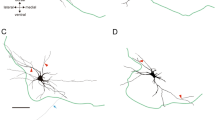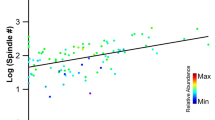Abstract
MAMMALIAN intrafusal muscle fibres are innervated by the small γ-efferent fibres of Leksell1, which have nerve-trunk diameters of 2–8µ. Fibre-size histograms of the intramuscular diameters of both intra- and extra-fusal efferents in fresh and gold chloride preparations show that, while both share the same peak at 3.5µ, about 30 per cent of the intrafusal efferents lie outside the extrafusal range at 4–6µ (ref. 2). These larger fibres have been reported in various descriptions of spindle innervation3–6; in cat rectus femoris, they take part in the innervation of about one-third of the spindles present (Adal and Barker, unpublished). They could be members of either the 2–8&µ γ-group, or the 8–18µ α-group, which have not undergone such extensive branching as the majority of their fellows. The work of Granit, Pompeiano, and Waltman7 on the α-activation of cat spindles directs attention to the possibility that some members of the α-group may branch so as to innervate both intra- and extra-fusal muscle fibres. Such a claim has been made by Weiss and Dutil8, Cilimbaris4, Wilkinson9, Denny-Brown10, and, more recently, Häggqvist11. Wilkinson (echidna spindles) and Häggqvist (monkey spindles) have each published a photograph purporting to show such innervation, but they are unconvincing and open to alternative interpretation. We have examined fifty gold chloride preparations of echidna (Tachyglossus aculeatus) spindles without finding instances of collaterals from α-fibres innervating intrafusal muscle fibres, and examination of more than two thousand gold chloride cat spindles, accumulated during work on various aspects of this receptor, has also failed to yield any instance of such innervation. Examination of bat, monkey, opossum, rabbit, and rat spindles has also proved negative in this respect. When apparent examples of such branching have been encountered, closer examination and further tracing has always shown the presence of two discrete fibres; in such instances, the two fibres are usually superimposed one above the other during their course before diverging, so as to give the impression of a single fibre branching into two. Similar instances occur with afferent fibres, and have led to claims8,12–14 of a single fibre branching so as to terminate in a spindle primary ending and a nearby tendon-organ. If branches of α-efferent fibres do innervate the mammalian spindle, we are of the opinion that the collaterals must originate some distance away from the receptor, either within the muscle nerve or within intramuscular nerve trunks. However, experimental evidence for the innervation of the spindle by a-efferents is conflicting15, and it seems, on balance, more probable that in mammalian muscle there are discrete intrafusal (γ) and extrafusal (α) efferent systems.
This is a preview of subscription content, access via your institution
Access options
Subscribe to this journal
Receive 51 print issues and online access
$199.00 per year
only $3.90 per issue
Buy this article
- Purchase on Springer Link
- Instant access to full article PDF
Prices may be subject to local taxes which are calculated during checkout
Similar content being viewed by others
References
Leksell, L., Acta physiol. scand., 10, Supp. 31 (1945).
Barker, D., J. Physiol., 149, 7P (1959).
Barker, D., Quart. J. Micr. Sci., 89, 143 (1948).
Cilimbaris, P. A., Arch. mikr. Anat., 75, 692 (1910).
Cooper, S., and Daniel, P. M., J. Physiol., 133, 1P (1956).
Garven, H. S. D., Brain, 48, 380 (1925).
Granit, R., Pompeiano, O., and Waltman, B., J. Physiol., 147, 385 and 399 (1959).
Weiss, G., and Dutil, A., C.R. Soc. Biol., Paris, 290 (1896).
Wilkinson, H. J., Med. J. Austral., 2, 768 (1929).
Denny-Brown, D., in Creed, R. S., et al., Reflex Activity of the Spinal Cord (Clarendon Press, Oxford, 1932).
Häggqvist, G., Z. Biol., 112, 11 (1960).
Dogiel, A. S., Arch. mikr. Anat., 67, 638 (1906).
Hines, M., and Tower, S. S., Bull. Johns Hopkins Hosp., 42, 264 (1928).
Kerschner, L., Anat. Anz., 3, 288 (1888).
Hunt, C. C., and Perl, E. R., Physiol. Rev., 40, 538 (1960).
Author information
Authors and Affiliations
Rights and permissions
About this article
Cite this article
BARKER, D., CHIN, N. Efferent Innervation of Mammalian Muscle-spindles. Nature 190, 461–462 (1961). https://doi.org/10.1038/190461a0
Issue Date:
DOI: https://doi.org/10.1038/190461a0
This article is cited by
-
Fusimotorische Alpha-Reflexe an pr�tibialen Flexorenspindeln der Katze
Pfl�gers Archiv f�r die Gesamte Physiologie des Menschen und der Tiere (1967)
Comments
By submitting a comment you agree to abide by our Terms and Community Guidelines. If you find something abusive or that does not comply with our terms or guidelines please flag it as inappropriate.



